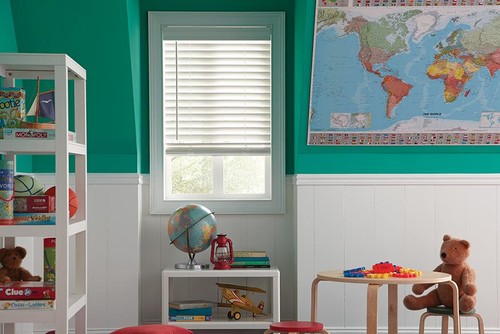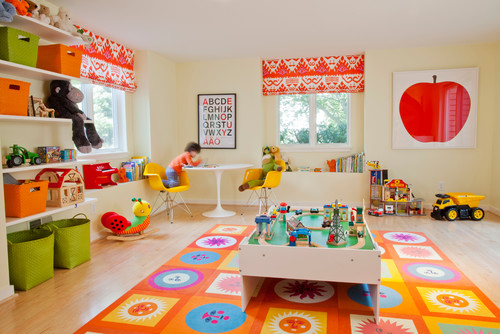
AnnaNahabed/iStock
Studies show that playtime is good for kids: They learn balance and coordination, develop skills, and exercise their imaginations as well as their bodies. That’s why many homeowners and renters with young ones like to have a designated place in their home for playtime activities. Plus, it’s nice to have a place to store all those toys so they don’t end up taking over the rest of the house.
A well-planned playroom can provide hours of stimulation and entertainment for your kids. But ill-informed design choices could spell wasted time, money, and square footage on a room that the little ones won’t be all that excited to use.
For maximum results, avoid the following blunders when outfitting the playroom in your home.
1. Forgetting to make it a kid-friendly space
This may seem obvious, but when designing a space for children, it’s important to consider their wants and needs, not necessarily what you want.
“Parents think the room will look like a photo from a design store, and it won’t—ever,” says Leigh Spicher, national director of design studios for Ashton Woods. It’s a playroom, not a parlor.
“Understand that anything you put in that room is going to be a canvas for any type of marker or paint, so while that luxurious linen may look tempting, go with fabrics that are durable and washable,” says Mark Cutler, designer and president of Mark Cutler Design, in Los Angeles. He recommends outdoor fabric that can be washed in bleach.
And don’t underestimate the importance of safety in this room.
“Playrooms can be rowdy places, so make sure the TV is safely anchored to the wall, along with the furniture it is on or near,” Spicher advises. Also consider cable concealers ($13.99, Amazon) to hide electrical cords.
2. Selecting the wrong window treatments
Floor-length curtains may look stylish, but sorry, parents, they don’t belong in the playroom.
“While aesthetically pleasing, we find these types of curtains often becoming an instrument for hand wiping or standing support for tiny tots,” says Jasmin Arya, senior stylist at Spiffy Spools. “They also pose a safety hazard, as little crawlers may entangle themselves in fabric.” The same goes for corded blinds.
A study by the Center for Injury Research and Policy found that from 1990 to 2015, an average of two kids were hurt each day (and one child died each month) in window blind–related accidents such as getting entangled in the cords.
Arya recommends Roman shades or blinds that don’t compromise aesthetics or safety.
“Either buy cordless or use chain locks for custom Roman shades to keep cords out of little ones’ reach,” she says.
3. Too many cabinets and drawers
We understand you want plenty of places to contain the clutter, but kids like easy access to their toys. That’s why a room full of cabinets and drawers won’t cut it in a playroom.
“Cabinets and drawers become dumping grounds for miscellaneous toys, and the kids never remember what is inside and do not bother to open them up to find out,” says Katy Winter, founder of Katy’s Organized Home, in Chappaqua, NY. She recommends open shelving with labeled bins.
Photo by Leighton Design Group
Carpet or rugs in a playroom need to be able to repel dirt, juice, and other messes. But one common mistake parents make, according to Ashley Manfred, a New York City–based interior designer, is using viscose rugs that are hard to clean.
“There are a lot of different names for the material—such as Tencel, bamboo silk, or faux silk—and they are gorgeous and soft, but extremely hard to clean.” In fact, she says, even water can damage them.
So what type of material should you choose for rugs or carpeting?
“Good old-fashioned wool or some of the new indoor/outdoor rugs are surprisingly soft and durable,” Manfred says. Also, don’t make the mistake of using fluffy rugs.
“They’re supersoft and inviting, but can be difficult for kids to play on since train sets, Magna-Tiles, and other toys don’t balance properly. And nothing’s worse than stepping on a hidden Lego in a furry minefield,” she says.
In fact, Komal Sheth, a real estate agent at Engel & Völkers Austin in Austin, TX, recommends tile rugs ($18 and up per piece, Flor). “They’re assembled in sections, so it’s easy to just remove, clean, or replace the tile that has spills or stains on it.”
5. Designing in a time warp
Your kids aren’t going to remain the same size forever, so don’t design the playroom as though they are.
Ben Soreff, a professional organizer at House to Home Organizing in Fairfield, CT, says he sees a lot of playrooms that don’t plan for growth. For example, if you build something that looks like a fort or a play structure, it will eventually need to be ripped out.
“This holds true for painted, kid-friendly scenes on the walls—as the kids grow or their tastes mature,” he points out. Instead of permanent paint, Soreff recommends stick-on decals that can be easily removed.
6. Picking the wrong paint or finishes
When picking colors, don’t make the mistake of choosing the wrong sheen. In a high-traffic area like a playroom, sheen is very important, according to Brian Osterried, PPG senior product marketing manager.
“There are flat and eggshell sheens in high-quality acrylic paints that are designed for both durability and washability and won’t highlight the imperfections of your drywall as the high sheen of a semigloss finish often does,” he says.
And since this is your kids’ space, don’t forget to let them have a voice in the selection process.
“Have them pick a favorite color or color family, and find an option within that spectrum that works for you, too,” says Hannah Yeo, manager of color marketing and development at Benjamin Moore. “The playroom should be a space where kids enjoy spending time, and it should boost their creativity.”
The post 6 Design Mistakes You’re Making With Your Kids’ Playroom appeared first on Real Estate News & Insights | realtor.com®.


No comments:
Post a Comment